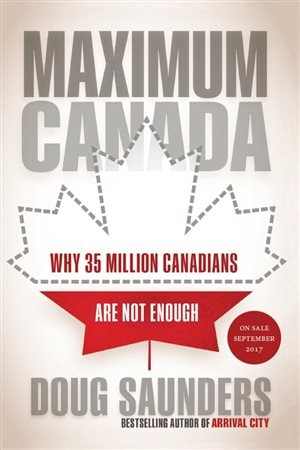‘Maximum Canada: Why 35 Million Canadians Are Not Enough”, is the latest book from author and journalist Doug Saunders.
In it he argues that this country needs a lot more people; triple the current population, he says.
Saunders is the former London bureau chief and now the international columnist for the Globe & Mail, one of Canada’s national newspapers.
ListenHe has a global view of many issues, and says in his time abroad, he had the opportunity to reflect, and write about Canada from a distant perspective.
“Much of Toronto is dangerously under-populated with only single-family houses”

What he’s suggesting may come as a shock to the citizens of Canada’s largest cities, who can’t imagine a tripling of the population as they sit stuck in traffic, or endure crowded commutes between home and work.
“Much of Toronto is dangerously under-populated with only single-family houses”, Saunders says.
“Our largest cities are stuck at a point where they’ve become too large for their existing infrastructure, their existing collections of equipment” he explains.
The solution for these cities, according to Saunders: “They need to snap up to another larger level at maybe twice their population in order to have the sustainable systems that can support the people.”
Saunders begins the book by illuminating how our history and tradition left us in this situation. He describes Canada’s evolution as having been under the “minimising impulse”.
“Between about the end of the War of 1812, and the end of the Second World War, Canada pursued a set of policies designed to limit its scope, to limit its economic role, to limit its diversity, to close the border with the United States to trade, so that it would be a country that existed to provide raw materials to Britain and other remote places.” Saunders said, in an interview last week.
It may come as a surprise to many Canadians to know that in the first hundred years of our history, almost as many immigrants left Canada, as came to Canada.
He says it’s now time to welcome and settle people and to encourage population growth.
“It’s not all about immigration”
“Our consumer markets are too small to have independent Canadian companies that can stay viable and compete, our taxpayer base is too small to support the sorts of government services and so on that we need at a scale we have come to expect, and most importantly, we do not have the population density to make a transition to a carbon-neutral economy, Saunders says.
“We live in a very ecologically unsustainable way because of the low population density across Canada and especially in its largest cities, and we need to build up concentrations of people both for economic reasons, for ecological reasons, and also for cultural reasons.”
Beyond our largest urban centres, Saunders says its the mid-size cities across Canada that have the most to gain, particularly those with universities and community colleges.
“Those are the places where immigrants want to settle now. Those are the places that should become the hubs of knowledge and entrepreneurship and invention in Canada.”
“We don’t have very good family policies.”
He says these cities should begin to envision themselves as becoming major cities, with high-speed links to the larger centres.
“It’s not all about immigration” Saunders says. “A large part of Canada’s population deficit is a result of the fact that we don’t have very good family policies.”
And we have a fertility gap, that’s the difference between the amount of children young couples would like to have, and the size of the family they eventually do have.
Saunders says seven out of ten Canadians say they found they could not afford to have that extra child.
“I think it’s important, to recognize in the future, that we need to include existing Canadian families in any population plan, partly because it’s the right thing to do because we do make it very difficult for people to have families of the size they want, but also because it makes it politically more viable, rather than seeing immigrants as competitors for resources and that sort of thing, established Canadian families see themselves as being co-participants in a shared project.”
While Canada, like many other western countries, is living through a demographic shift to a significantly older population, the federal government has boosted immigration quotas by 50,000 to 300.000 new arrivals annually.
According to Doug Saunders, that’s getting close to the target. And in the meantime we can continue developing more progressive family policies.
All food for thought as we begin a new year.







For reasons beyond our control, and for an undetermined period of time, our comment section is now closed. However, our social networks remain open to your contributions.